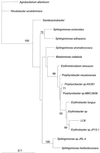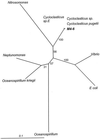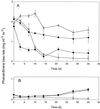Isolation, characterization, and polyaromatic hydrocarbon degradation potential of aerobic bacteria from marine macrofaunal burrow sediments and description of Lutibacterium anuloederans gen. nov., sp. nov., and Cycloclasticus spirillensus sp. nov
- PMID: 11722910
- PMCID: PMC93347
- DOI: 10.1128/AEM.67.12.5585-5592.2001
Isolation, characterization, and polyaromatic hydrocarbon degradation potential of aerobic bacteria from marine macrofaunal burrow sediments and description of Lutibacterium anuloederans gen. nov., sp. nov., and Cycloclasticus spirillensus sp. nov
Abstract
Two new polyaromatic hydrocarbon-degrading marine bacteria have been isolated from burrow wall sediments of benthic macrofauna by using enrichments on phenanthrene. Strain LC8 (from a polychaete) and strain M4-6 (from a mollusc) are aerobic and gram negative and require sodium chloride (>1%) for growth. Both strains can use 2- and 3-ring polycyclic aromatic hydrocarbons as their sole carbon and energy sources, but they are nutritionally versatile. Physiological and phylogenetic analyses based on 16S ribosomal DNA sequences suggest that strain M4-6 belongs to the genus Cycloclasticus and represents a new species, Cycloclasticus spirillensus sp. nov. Strain LC8 appears to represent a new genus and species, Lutibacterium anuloederans gen. nov., sp. nov., within the Sphingomonadaceae. However, when inoculated into sediment slurries with or without exogenous phenanthrene, only L. anuloederans appeared to sustain a significant phenanthrene uptake potential throughout a 35-day incubation. In addition, only L. anuloederans appeared to enhance phenanthrene degradation in heavily contaminated sediment from Little Mystic Cove, Boston Harbor, Boston, Mass.
Figures








Similar articles
-
PAH-degradation by Paenibacillus spp. and description of Paenibacillus naphthalenovorans sp. nov., a naphthalene-degrading bacterium from the rhizosphere of salt marsh plants.Int J Syst Evol Microbiol. 2002 Jan;52(Pt 1):131-139. doi: 10.1099/00207713-52-1-131. Int J Syst Evol Microbiol. 2002. PMID: 11837295
-
Thalassospira tepidiphila sp. nov., a polycyclic aromatic hydrocarbon-degrading bacterium isolated from seawater.Int J Syst Evol Microbiol. 2008 Mar;58(Pt 3):711-5. doi: 10.1099/ijs.0.65476-0. Int J Syst Evol Microbiol. 2008. PMID: 18319483
-
Haloferula rosea gen. nov., sp. nov., Haloferula harenae sp. nov., Haloferula phyci sp. nov., Haloferula helveola sp. nov. and Haloferula sargassicola sp. nov., five marine representatives of the family Verrucomicrobiaceae within the phylum 'Verrucomicrobia'.Int J Syst Evol Microbiol. 2008 Nov;58(Pt 11):2491-500. doi: 10.1099/ijs.0.2008/000711-0. Int J Syst Evol Microbiol. 2008. PMID: 18984682
-
Psychrophilic sulfate-reducing bacteria isolated from permanently cold arctic marine sediments: description of Desulfofrigus oceanense gen. nov., sp. nov., Desulfofrigus fragile sp. nov., Desulfofaba gelida gen. nov., sp. nov., Desulfotalea psychrophila gen. nov., sp. nov. and Desulfotalea arctica sp. nov.Int J Syst Bacteriol. 1999 Oct;49 Pt 4:1631-43. doi: 10.1099/00207713-49-4-1631. Int J Syst Bacteriol. 1999. PMID: 10555345
-
Isolation of marine polycyclic aromatic hydrocarbon (PAH)-degrading Cycloclasticus strains from the Gulf of Mexico and comparison of their PAH degradation ability with that of puget sound Cycloclasticus strains.Appl Environ Microbiol. 1998 Dec;64(12):4703-10. doi: 10.1128/AEM.64.12.4703-4710.1998. Appl Environ Microbiol. 1998. PMID: 9835552 Free PMC article.
Cited by
-
Variation of Oxygenation Conditions on a Hydrocarbonoclastic Microbial Community Reveals Alcanivorax and Cycloclasticus Ecotypes.Front Microbiol. 2017 Aug 16;8:1549. doi: 10.3389/fmicb.2017.01549. eCollection 2017. Front Microbiol. 2017. PMID: 28861063 Free PMC article.
-
Biofilm comprising phototrophic, diazotrophic, and hydrocarbon-utilizing bacteria: a promising consortium in the bioremediation of aquatic hydrocarbon pollutants.Environ Sci Pollut Res Int. 2013 May;20(5):3252-62. doi: 10.1007/s11356-012-1251-z. Epub 2012 Oct 23. Environ Sci Pollut Res Int. 2013. PMID: 23089957
-
Polycyclic Aromatic Hydrocarbon (PAH) Degradation Pathways of the Obligate Marine PAH Degrader Cycloclasticus sp. Strain P1.Appl Environ Microbiol. 2018 Oct 17;84(21):e01261-18. doi: 10.1128/AEM.01261-18. Print 2018 Nov 1. Appl Environ Microbiol. 2018. PMID: 30171002 Free PMC article.
-
Uptake of carbon monoxide and hydrogen at environmentally relevant concentrations by mycobacteria.Appl Environ Microbiol. 2003 Dec;69(12):7266-72. doi: 10.1128/AEM.69.12.7266-7272.2003. Appl Environ Microbiol. 2003. PMID: 14660375 Free PMC article.
-
Evaluating bacterial community structures in oil collected from the sea surface and sediment in the northern Gulf of Mexico after the Deepwater Horizon oil spill.Microbiologyopen. 2013 Jun;2(3):492-504. doi: 10.1002/mbo3.89. Epub 2013 Apr 9. Microbiologyopen. 2013. PMID: 23568850 Free PMC article.
References
-
- Aitken M D, Stringfellow W T, Nagel R D, Kazunga C, Chen S H. Characteristics of phenanthrene-degrading bacteria isolated from soils contaminated with polycyclic aromatic hydrocarbons. Can J Microbiol. 1998;44:743–752. - PubMed
-
- Aller R C. Benthic fauna and biogeochemical processes in marine sediments: the role of burrow structures. In: Blackburn T H, Sorensen J, editors. Nitrogen cycling in coastal marine environments. Chichester, England: John Wiley & Sons; 1988. pp. 301–338.
-
- Anderson F E, Black L, Watling L E, Mook W, Mayer L M. A temporal and spatial study of mudflat erosion and deposition. J Sediment Petrol. 1981;51:729–736.
-
- Ashok B T, Saxena S, Musarrat J. Isolation and characterization of four polycyclic aromatic hydrocarbon degrading bacteria from soil near an oil refinery. Lett Appl Microbiol. 1995;21:246–248. - PubMed
-
- Balkwill D L, Drake G R, Reeves R H, Fredrickson J K, White D C, Ringelberg D B, Chandler D P, Romine M F, Kennedy D W, Spadoni C M. Taxonomic study of aromatic-degrading bacteria from deep-terrestrial-subsurface sediments and description of Sphingomonas aromaticivorans sp. nov., Sphingomonas subterranea sp. nov., and Sphingomonas stygia sp. nov. Int J Syst Bacteriol. 1997;47:191–201. - PubMed
Publication types
MeSH terms
Substances
Associated data
- Actions
- Actions
LinkOut - more resources
Full Text Sources
Molecular Biology Databases

